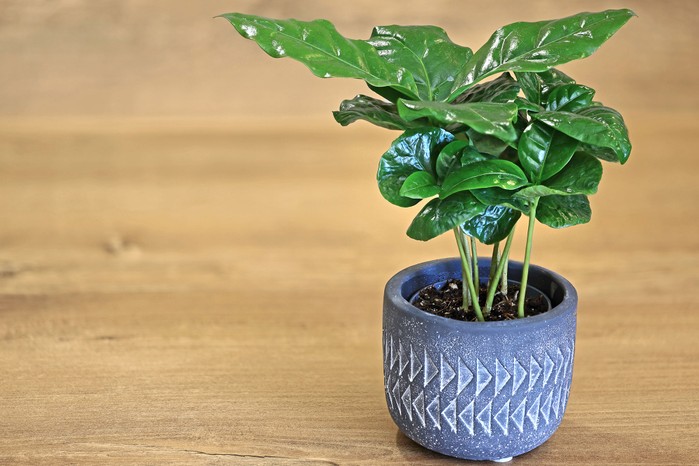
Coffea arabica, the coffee plant, is an attractive shrub with glossy green leaves and clusters of scented white flowers in early summer. In its native habitat a coffee plant can grow up to 8m tall, but it can be grown in the UK as a house plant.
As a house plant, a coffee plant makes an impact all year round with evergreen leaves that are slightly ruffled at the edges. Once mature, after about four years, you may also get highly fragrant white flowers, followed by green fruits that ripen and turn red, then almost black. The two seeds inside each fruit are the coffee beans.
It’s not going to be a big harvest but a coffee plant grown in the right conditions might produce enough for an espresso. The beans will need to be roasted before being ground. It’s the roasting of the beans that produces the coffee aroma. Although it would take a number of mature bushes to produce a sizeable harvest, attempting to grow your own coffee is a fun project.
Coffea arabica is native to tropical areas of Africa and Asia, so it needs a warm spot out of direct sunlight in order to thrive.
All parts of the coffee plant, apart from the beans, are toxic to humans and animals.
How to grow a coffee plant
Coffee plants need a warm spot with bright, indirect light. They’re best grown as house plants or in a greenhouse. Their ideal growing temperature is 16-24ºC. Water regularly, keeping the compost moist but not waterlogged. Feed every two weeks during the growing season with a liquid feed. Keep humidity levels high by standing the plant in a tray of pebbles filled with water, and misting the leaves regularly.
Where to grow a coffee plant
Coffee bean house plant. Getty Images
Coffea arabica will do best in bright, indirect light. Avoid full sun as the leaves will get scorched and turn brown, and keep away from draughts. These plants need a temperature of around 16-24ºC and a slightly lower temperature during winter. A conservatory or light bathroom would be ideal for a coffee plant as they like bright light and humidity.
How to plant Coffea arabica
Repot your coffee plant every two to three years. The best time to do this is in the spring. Pot on into the next container size up using loam-based, peat-free compost.
Caring for a coffee plant
Feed your coffee plant every two weeks during the growing season (March to September) with a liquid feed. Keep the compost moist but reduce watering during the winter when the plant is dormant.
For more on house plant care:
How to propagate a coffee plant

Getty Images
Coffee plants have red berries and these contain two seeds, which will turn into coffee beans. You can buy a coffee plant in a pot, but you can also grow it from seed. Soak seeds overnight (but no longer as they may rot) and then sow on to the surface of moist compost. Cover with a thin layer of compost and keep at a temperature of around 27-29ºC. It can take six to eight weeks for seeds to germinate. Transplant seedlings once they are big enough to handle.
How to prune
In the wild, coffee plants will grow to 4-8m over a period of five to 10 years, but when grown indoors in a pot, they can be pruned to keep them to a manageable size. Cut back in the spring. Cut stems at a 45 degree angle just above a leaf joint.
Pests and diseases
Red spider mite
Coffee plants can be affected by glasshouse red spider mite, which feeds on the sap of the plant. This causes leaf drop and mottled leaves. These mites thrive in warm conditions and are usually a problem during the growing season. Look out for fine webbing on the leaves and stems as well as mites and eggs on the underside of leaves. Take preventative action by spraying with water to increase humidity. Biological controls are available to deal with infestations.
Xylella fastidiosa
Coffee plants are high risk for carrying a bacterium called Xyella. This can cause dieback, leaf scorch and ultimately kill the plant. Source your plant from a reputable nursery and check that your plant is UK grown. Plants that have been raised in the UK are at low risk for this disease.
Advice on buying a coffee plant
- Coffee plants are available from several house plant nurseries
- Alternatively, you can buy seed from specialist nurseries and grow the plants yourself
- Buy from well known nurseries and check your plant is healthy on arrival with no pests.
- There is a dwarf variety available Coffea arabica ‘Nana’ which is a good choice for indoor growing and will require less pruning.
